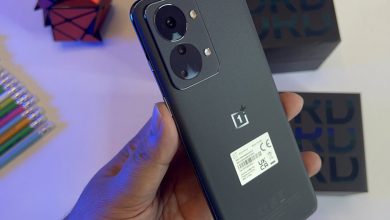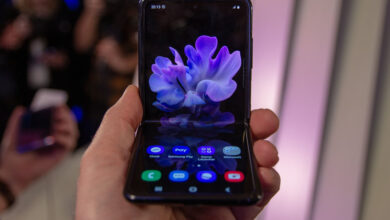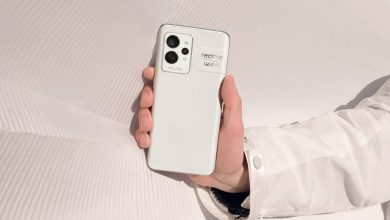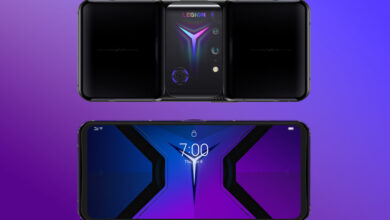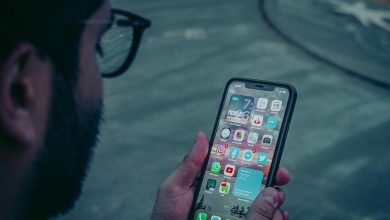Samsung Galaxy Z Flip 4 initial review: Flippin’ great
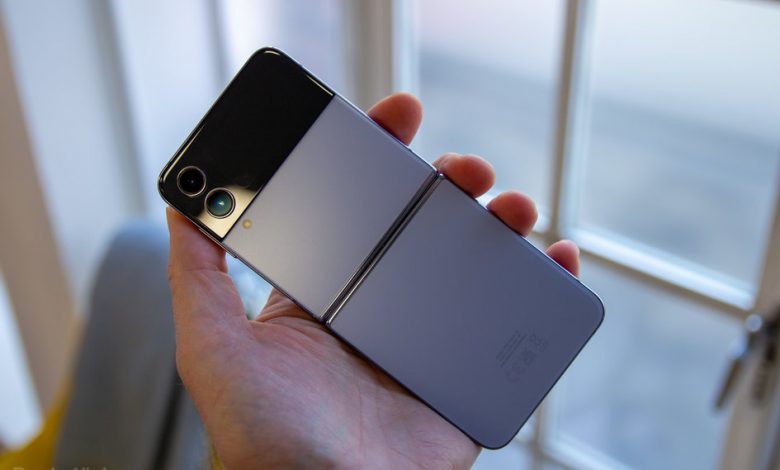
[ad_1]
(Pocket-lint) – While Samsung’s Z Flip might be seen as the lesser of the Z folding models, it outsells the Z Fold by a considerable margin. That makes the Galaxy Z Flip 4 an important update for Samsung, as this is likely to be the volume seller from Samsung’s folding phone family.
One of the secrets of the Z Flip’s success is the fact that it delivers on that folding phone promise: it gets smaller when folded, so it’s not only more convenient, but it carries those nostalgia vibes of flip phones of the past too.
We spent some time with the Z Flip 4 prior to launch.
The Samsung Galaxy Z Flip 4 shows plenty of promise with a range of tweaks to make this folding phone a little more attractive. The shift in the design makes it look better, while the flagship-grade hardware will mean there’s no problem around power.
With plenty of customisation options, it’s easy to get the design of phone that you want – and to be able to stand out from the crowd. The Z Flip has already proven to be the folding phone of choice for many customers and on first impressions, there’s no reason why the Z Flip 4 won’t continue that trend.
- Premium design
- Lots of customisation options
- Great display
- IPX8 protection
- Charging not the fastest
- Display durability remains a problem
squirrel_widget_12854663
Design and build
- 84.9 x 71.9 x 17.1mm (folded); 165.9 x 71.9 x 6.9mm (unfolded), 187g
- IPX8 protection
- 75 different colour options
The Samsung Galaxy Z Flip looks more like a regular Samsung phone with every iterative update. Now in its fourth-gen, the 2022 Z Flip slims down the hinge and takes a subtly different approach to the design to make it look better.
The rear panels now appear more seamless, reducing the framing next to the hinge, so the whole thing looks more modern and sophisticated. The camera is larger on the back, fitting in with design trends on recent phones, with a bolder overall aesthetic.

There remains the option to build your own Z Flip, with 75 options through the Samsung Bespoke designer – so if you don’t fancy the Graphite, Pink Gold, Bora Purple or Blue standard options, you can basically have whatever you like, with three frame colours, and five colour options for the front and back panels.
There’s a nice matte finish to those colours, with the Bora Purple and Blue standing out. (Bora is the Korean for purple, if you didn’t know.)

There remains IPX8 protection against water ingress (note there’s no dust protection) meaning that if you get caught in the rain, the Z Flip 4 won’t care.
Importantly, the Z Flip 4 feels premium and looks great: the colour options provide the opportunity to create something unique to you, while that folding action is still incredibly satisfying – we love the finality of closing your phone and slipping it into a pocket.
Display
- Inner: 6.7in AMOLED, 2640 x 1080 pixels, 425ppi, 1-120Hz
- Outer: 1.9in AMOLED, 512 x 260 pixels, 302ppi
There are two displays on the Z Flip 4, the main 6.7-inch folding display on the interior, with a 1.9-inch display on the exterior. These sit close to the offering on the Z Flip 3, with Samsung saying that there an now more options for this external display.
You’ll now get themes that flow from the inside to the outside, you’ll be able to apply widgets to this cover screen so you can glance at the information you need.
The exterior display is more of an information screen, although there’s a range of options it offers, including as a camera viewfinder as well as being able to just feed you information when you need it.

The internal display, however, remains pretty much as it was previously, covered with UTG – ultra thin glass – over the flexible display.
There’s an adaptive refresh rate, so you’ll get 120Hz to keep content smooth, while there’s also plenty of detail. First impressions are of a great AMOLED display, with those deep blacks and plenty of vibrancy to the colour.

Based on the short time we’ve spent with the Z Flip 4 so far we can’t pass any definitive judgements on its performance, but first impressions suggest it’s going to be similar to the Z flip 3 that it replaces.
Of course, the other big appeal of having a folding phone is using Flex Mode, being able to sit the phone down and still use the camera without having to balance it precariously.
But it’s impossible to ignore the fact that the durability on these displays isn’t the same as it is on a regular phone. With many opting for the Galaxy Z Flip 3, there’s no shortage of people who’ve had to have the screen replaced because it started to separate. There’s great novelty in this format of phone, but you do need to be aware of the downsides too.
Hardware and performance
- Snapdragon 8+ Gen 1, 8GB RAM
- 128, 256, 512GB options
- 3700mAh, 25W wired charging, 15W wireless
There’s no shortage of power in the Galaxy Z Flip 4; with the Snapdragon 8+ Gen 1, this phone has the latest hardware, so everything should be smooth and fast. There’s 8GB RAM and storage options from 128GB.
That should see the Z Flip 4 keep pace with other flagship devices, meaning you’re not making a compromise by choosing this format of phone.

There’s a 3700mAh battery split between the two halves of the Z Flip 4, but from the short time we’ve spent with the device, we can’t gauge its performance. It will support 25W wired charging as well as wireless charging.
We’ll be spending much more time assessing the battery life and overall performance of this device when we get it back in hand for a full review.
Cameras
- Dual rear camera system:
- Main: 12MP, 1.8μm, f/1.8, OIS
- Ultrawide: 12MP, 1.12μm, f/2.2
- Front: 10MP, 1.22μm, f/2.4
There are two 12-megapixel cameras on the rear of the Samsung Galaxy Z Flip 4, but there’s been a change of sensor from the Galaxy Z Flip 3, with Samsung saying that the new camera is 65 per cent brighter, as it moves from 1.4μm to 1.8μm, so it’s a larger sensor overall.
That should aid in the capture of light, leading to better images and an improvement in performance in lower light conditions.

The second camera is ultrawide – there’s no optical zoom on the Z Flip 4. The front camera is a 10-megapixel punch hole set in the display.
As we mentioned before, the unique thing about the Z Flip is that the design allows for a lot of flexibility in how you use the cameras. Flex Mode will mean you can preview what the camera is looking at on the top half, while the bottom half of the screen can give you the controls.
This isn’t just limited to Samsung’s camera, however, as the company has worked to bring support to other common camera apps you might be using.

There are also some clever options like auto framing, which can adapt the frame of the video camera to fit more in. For example, if you’re filming yourself the camera will be focused on you, but when you’re joined by a friend, it can give a wide view so you’re both in the frame.
Being able to bend the phone 90 degrees and then watch yourself on the screen when using the front camera is a great option and ideal for so many social video functions. You can also use the exterior display as a viewfinder when using the exterior camera for selfies.
As to the absolute performance, we can’t pass comment until we’ve fully reviewed the phone – but we’re expecting a similar good experience as we found on the Z Flip 3.
Software
- Android 12 with One UI 4.1.1
Unlike the Z Fold 4, the rather more conventional display on the Z Flip 4 means you don’t need the same degree of customisation to get the most out of it. For most apps, you’ll use the phone exactly as you would any other.
But there are some Flex customisations to help you better use the display when the phone is bent.
First impressions of the Samsung Galaxy Z Flip 4 are really positive: the interface appeared to be fast and fluid, but we’ll save judgement until we’ve completed our review.
squirrel_widget_12854663
The Samsung Galaxy Z Flip 4 makes a few important updates to this popular folding phone, resulting in a better-looking device, and bringing the power up to date. There’s novelty in the design and many will love the customisation that it offers, while the upgraded camera will likely appeal too. But the reality is that these phone displays just don’t last as long – and that’s something you need to consider when buying.
Writing by Chris Hall.
[ad_2]
Source link


